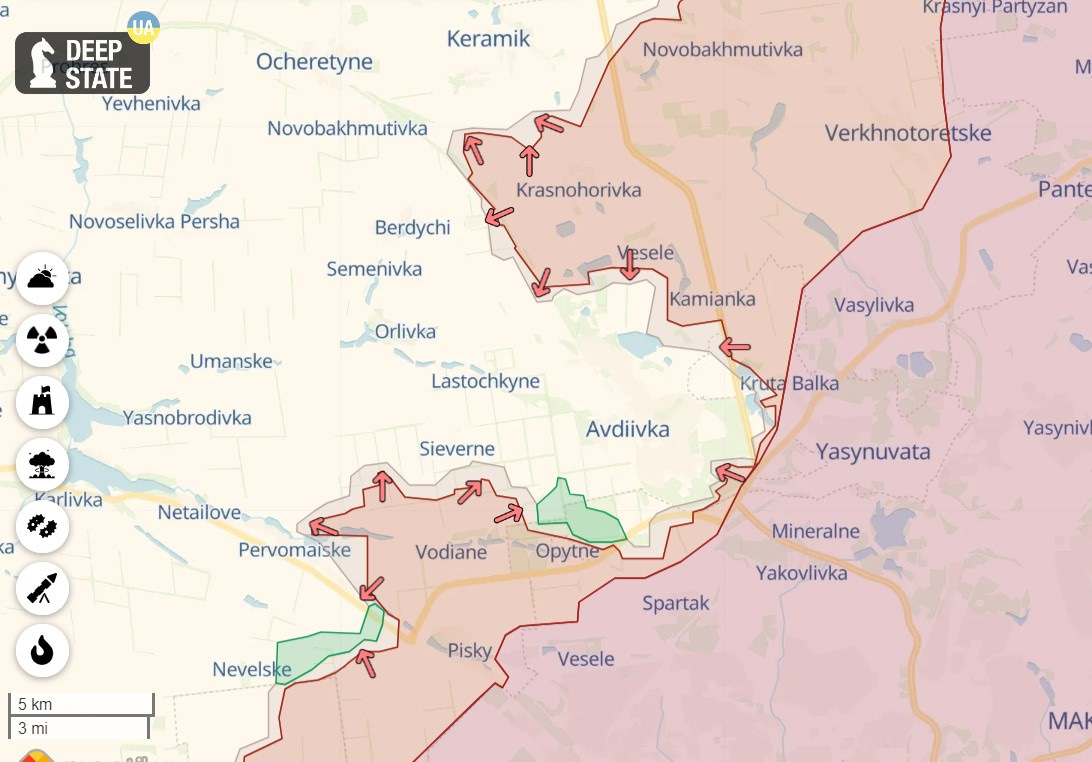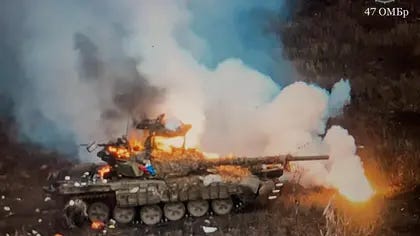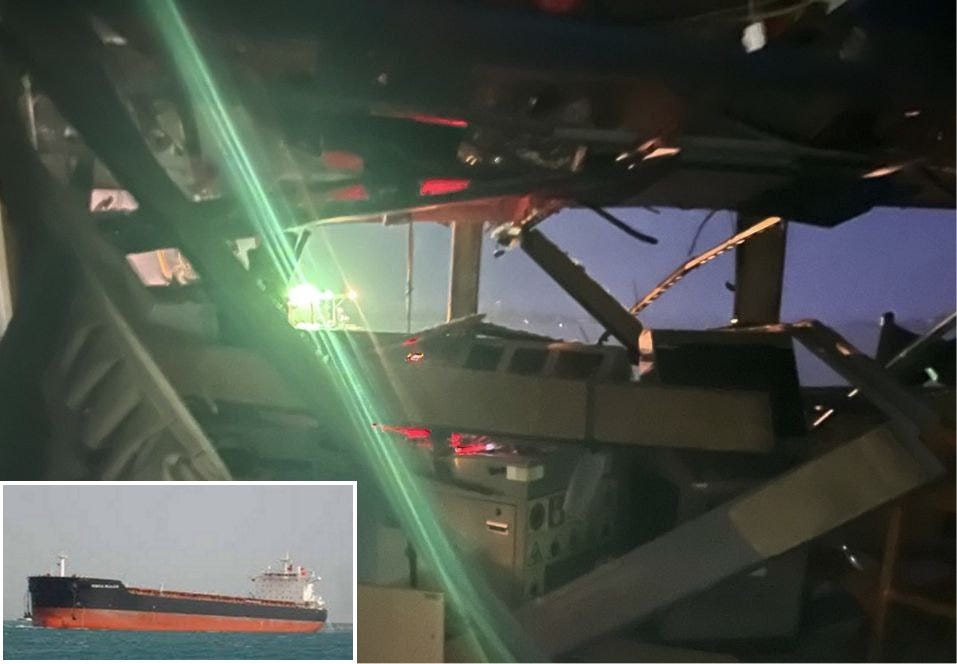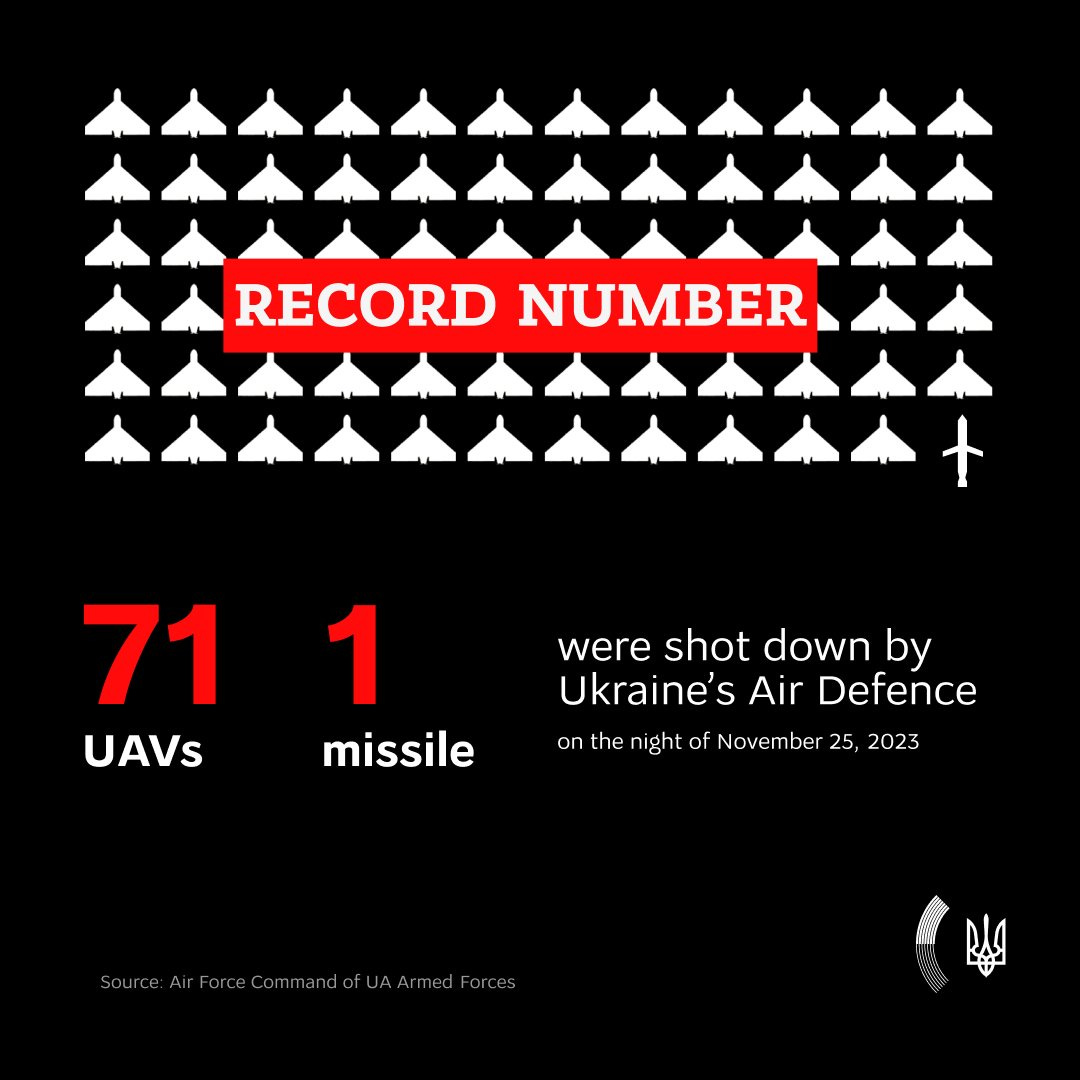Winter has walloped Ukraine with a heavy early season snowfall - and it appears to be working to the Ukrainians advantage.
On all three major fronts - Avdiivka, Kherson/Cross-Dnipro and in the Black Sea, Ukrainian forces are either advancing, inflicting devastating casualties on the Russians or sustaining their economically essential grain exports by preventing Russian interference. It is an impressive display of strategic power. JL
Phillips O'Brien reports in his substack:
At Avdiivka, the calculation for Ukraine remains the same as at Bakhmut—can they extract many more casualties from the Russians and destroy many more pieces of Russian equipment than they lose. If so, it is worth the effort for Ukraine. In Kherson, if the Ukrainians continue to make advances that's a positive sign the Russians have been unable to reinforce and that the Russians are being forced (further) from the riverbank. In the Black Sea/Crimea Ukraine continued to exert enough sea control to allow a large number of merchant ships to dock, load and leave with Ukrainian grain. Russian targets in Crimea are extremely vulnerable to western ranged weapons (ATACMS, Storm Shadows).We focus on 3 different areas of fighting: around the town of Avdiivka, on the Kherson Front and in the Black Sea Crimea front. might be worth updating on these since we recorded (which was monday) as they show the range of war fighting that is going on.
Avdiivka. This remains a brutal theater of war, though the Ukrainian decision to fight for the city remains sound. For those who havent followed this campaign much before, for two months now the Russians have committed major forces to try and take this small city (its pre-February 24, 2022 population was approx 34,000, so less than half the size of Bakhmut. Using the Deep State map (which uses arrows to show different recent attacks) you can see the Russians have recently tried to envelop the city from three different sides.
The carnage around the town looks absolutely gruesome. For a while it seems the Russians used the human wave tactics that they used around Bakhmut, and the results were extremely heavy losses.
Some of the videos coming out of the fighting are pretty horrible, with fields of dead bodies.
https://x.com/IAPonomarenko/status/1728078630134136972?s=20
Just yesterday, the Ukrainians were reporting that the Russians were throwing more forces into the fight and attacking from multiple places.1 It does seem that Putin is willing to expend massive resources to take the city for political reasons (he wants to seize anything he can in the area he has illegally annexed). I know people talk about the strategic value of Avdiivka’s roads, though that is less convincing to me, as fast, road breakouts seem almost impossible in this war unless the other side is extremely weak.
As such, the calculation for Ukraine should remain the same as at Bakhmut—can they extract many more casualties from the Russians and destroy many more pieces of Russian equipment than they lose. If so, in this battle of attrition, it is worth the effort for Ukraine. This war has confirmed a major technological advantage for the side on the defensive. As Ukraine’s main way to move forward later will be to weaken Russian forces so much that a part of the Russian line will become vulnerable, the more the Russians attack and turn the technological/defensive advantage over to Ukraine. It looks very much like the Ukrainians will fight in Avdiivka for as long as the Russians are willing to commit mass to try and take the town.
Kherson—or over the Dnipro
In the podcast, we tried to warn against too much excitement that the Ukrainian campaign to build up forces on the left bank of the Dnipro (the eastern bank) would lead quickly to a major victory. And hopefully such caution makes sense. There will be no heavy bridge available over the river for a long time, and a pontoon type bridge looks almost as risky. If its within artillery range of Russian units, it could too easily be hit. As such, getting supplies to Ukrainian forces on the Left banks will continue to be done by boat and UAV.
Considering the light weight of supplies that can be provided, its more than likely that the campaign will see incremental advances by the Ukrainians. Clearly the Russians dont have the kinds of forces in Kherson than the do in Zaporizhzhia for instance, as the Ukrainians seem able to hold their bridgehead in Kherson.2 Expanding the bridgehead will take time, though the key thing to see is if the Ukrainians continue to make small advances. If they do, thats quite a positive sign that the Russians have been unable to send much force there for reinforcement and an indication that the Russians are being forced more and more from the riverbank (providing greater security for Ukrainians living on the right (west) bank and making supply easier.
So watch it, but dont expect dramatic changes.
Black Sea/Crimea
This continues to be a remarkable success story for Ukraine in one way, which, as I said in the podcast, is one of the reasons that I hate to discuss the war as being in a stalemate. The Ukrainians continue to exert enough sea control in the western Black Sea to allow a large number of merchant ships to dock, load and leave with Ukrainian grain. The number of merchant ships which have left Ukraine so far this year (after the grain shipment deal was ended by Russia and a Russian blockade declared in operation) is now about 150 (as the Lithuanian Foreign Secretary commented about.3 This is particularly notable because early in November, the Russians actually attacked a Liberian-flagged merchant vessel as it was entering Odessa.4 If they were expecting this to deter shipping into Ukraine, its failed.
I remember a few months ago when people were so excited to see 2 ships make it out of Odessa to safety. Now its so common that its hardly mentioned. That is an extraordinarily positive development in the war at sea—and shows that the initiative remains with Ukraine.
Crimea is a more mixed story, and here the frustration will show. The Ukrainians are still doing everything possible in their powers to bring the war to Russian forces in Crimea. This week there were reports that the Ukrainians had launched a mass drone attack on Crimea (stated by Russian forces).5 However drone attacks on Crimea are still not going to do the kind of damage Ukraine needs. The payloads are not yet high enough to destroy certain heavy targets (naval base equipment, bridges, etc).
What we have seen repeatedly is that Russian targets in Crimea (Sevastopol, logistics, depots) are extremely vulnerable to western ranged weapons. What the Ukrainians have done with a small number of storm shadow/scalp cruise missiles stands out. And yet, here we are, knowing what Ukraine needs to win the war in Crimea, and the signs are that the Ukrainians dont have the material they need.
They have gained the initiative in the war at sea and around Crimea, the question (as it was last fall after Ukrainian successes in the land war) is whether it will be armed well enough to keep it going.
40 Days Since ATACMS—Where is the Follow up?
Its now been 40 days since the Ukrainians used ATACMS in their devastating attack on the Berdiansk air field, destroying more helicopters in one day than Russia had lost so far in the war.
Weekend Update #51 ATACMS arrive
I remember at the time I could not get too excited, because this very late and limited delivery of ATACMS seemed to me not to portend a major delivery of the weapons to Ukraine. In the weekend update, I even wrote what I thought the bad news would be:
Bad News ATACMS. I still cant get too excited about this because its been 20 months since the Russians launched their full-scale invasion and only a small number of simple ATACMS have arrived. Reports stretch from somewhere between 12 and 20 in the first instance. This is not enough to wage a sustained campaign—indeed its enough to warn the Russians about their potential, but then give the Russians time to make counters. Moreover, it shows that, the Russian escalation bluff remains potent—even when time and time again its shown to be a bluff. Remember when it was said Ukraine could not get ATACMS because Russia would go nuclear—well we see Putin’s own reaction to this first ATACMS attack and its the opposite.
Well, since then there might have been one more attack with ATACMS—and for the last few weeks there has been nothing confirmed.
To be frank, this is a sign that the Biden Administration never wanted to give them in the first place, and is still strictly limiting what they will give Ukraine. What have we seen—fewer than 20 seem to have been launched, and these are the shorter range ATACMS with the less powerful warheads. In the meantime, Russia has been signalled that Ukraine has them, and knowing how the Russians adjust (only once they have been hit), this has given the Russians the chance to save their forces.
I cant think of a worse way to aid Ukraine—in many ways its counterproductive. Russia will gain some benefits from arming Ukraine in this limited and peacemeal fashion. I know Ive been banging the drum about this question for a while—but when I see this and ask the question whether the US administration wants Ukraine to win the war? The answer I see is “no”.
Record Shahed Attack
Last night the Ukrainians claimed that the Russians launched their largest Shahed UAV attack of the war on Ukrainians cities/infrastructure. It was so large that the Ukrainians claimed to have shot down 71—which really does stand out in the history of the war so far. At the same time the Ukrainians claimed that there was only one missile used in the attack, and that this was shot down as well.
This imbalance remains striking. I went into what it means in some detail two weeks ago in the weekend update (which is still free to access for all).
I wrote at the time that the big difference this winter would be Russian reliance on Shaheds as they had basically stockpiled the same number of missiles that they had last winter (with which the ran the campaign that failed in the end). What they seem to be doing now is mass using the Shaheds early in the campaign (to see what they can accomplish and to test Ukrainian air defenses). The attack last night certainly stands out—they probably wanted to see if they could get a number of the shaheds through to hit targets and at the same time to see how Ukrainian air defenses reacted. At the same time they tried to sneak one missile (probably aimed at a very high value target) in the midst of all the Shahed madness.
The expectation is that they will ramp up the use of missiles (last nights attack might herald the start of a pretty intense phase). At least for now, Ukrainian air defense is coping well. Remember its much stronger than it was last winter.


























0 comments:
Post a Comment